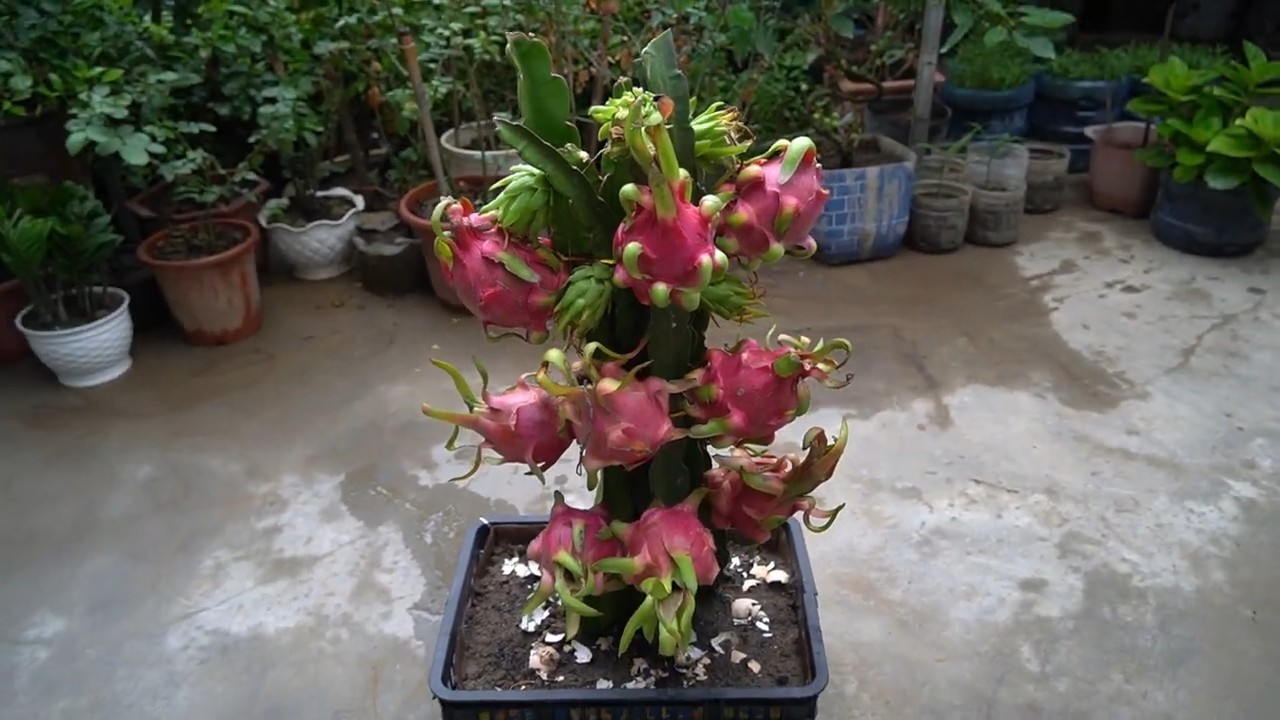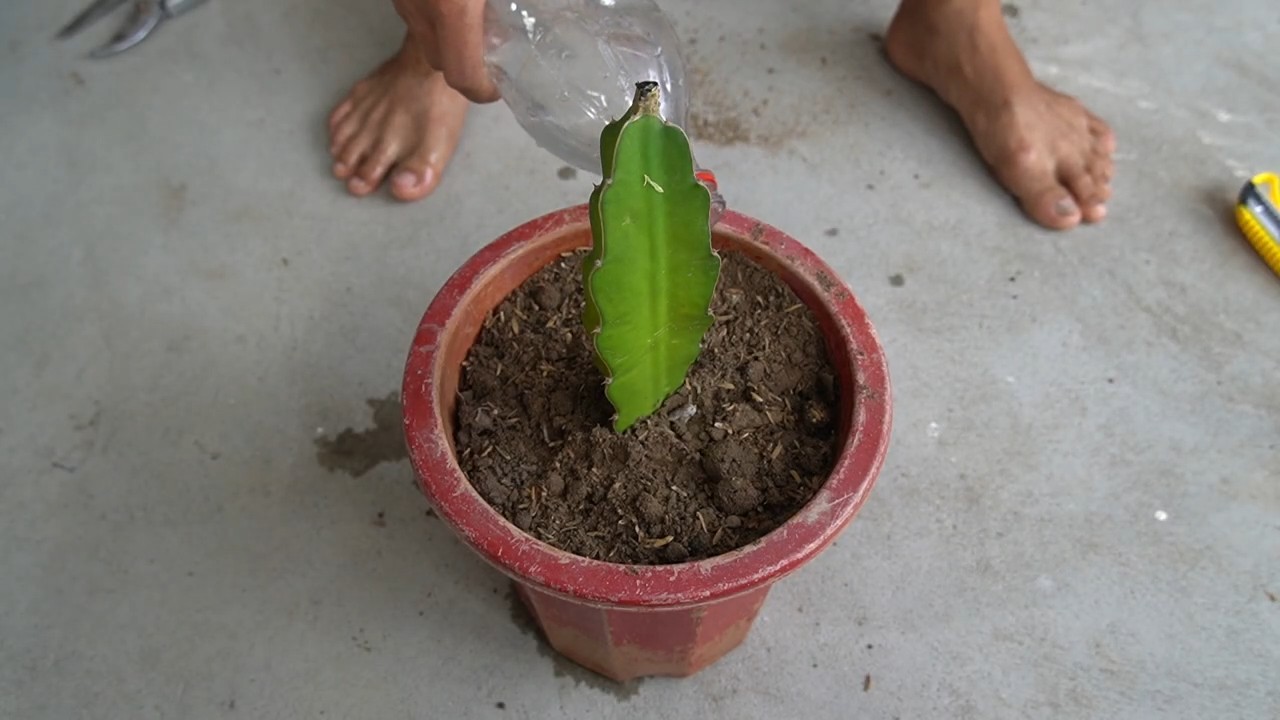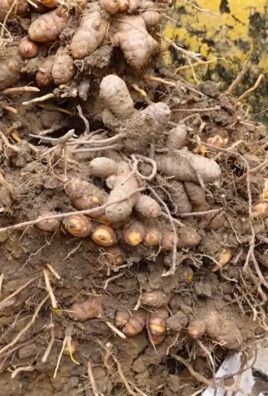Dragon Fruit Cuttings Propagation: Ever dreamt of having your own exotic dragon fruit vine cascading with vibrant, otherworldly fruit? Imagine plucking a sweet, juicy dragon fruit straight from your backyard – it’s easier than you think! For centuries, cultivating unique and delicious fruits has been a source of pride and sustenance for communities around the globe. Now, you can join this tradition with a simple, rewarding DIY project.
This article is your ultimate guide to mastering dragon fruit cuttings propagation. Forget expensive nursery plants; we’ll show you how to transform a simple cutting into a thriving dragon fruit plant. Why spend a fortune when you can easily multiply your dragon fruit supply with a few simple steps? This DIY trick is essential for anyone looking to expand their garden on a budget, share the joy of dragon fruit with friends, or simply experience the satisfaction of nurturing a plant from scratch. Plus, it’s a fantastic way to preserve unique varieties you might already have!
I’m excited to share these easy-to-follow instructions, ensuring your success in propagating dragon fruit from cuttings. Let’s get started and turn your gardening dreams into a delicious reality!

Drachenfrucht Vermehren: Dein DIY-Guide für Stecklinge
Hey Pflanzenfreunde! Hast du dich jemals gefragt, wie du mehr von dieser exotischen, leuchtenden Drachenfrucht in deinem Garten oder sogar auf deinem Balkon haben kannst? Die Antwort ist einfacher als du denkst: Stecklinge! Ich zeige dir, wie du mit ein paar einfachen Schritten und etwas Geduld deine eigenen Drachenfruchtpflanzen ziehen kannst. Es ist ein super lohnendes Projekt, versprochen!
Was du brauchst:
* Ein gesundes Drachenfrucht-Mutterpflanze: Das ist das A und O. Achte darauf, dass die Pflanze, von der du die Stecklinge nimmst, vital und frei von Krankheiten ist.
* Ein scharfes, sauberes Messer oder eine Gartenschere: Hygiene ist wichtig, um Infektionen zu vermeiden. Desinfiziere dein Werkzeug vorher mit Alkohol.
* Bewurzelungshormon (optional, aber empfohlen): Das hilft den Stecklingen, schneller Wurzeln zu bilden.
* Töpfe oder Behälter: Wähle Töpfe mit guter Drainage.
* Gut durchlässige Erde: Eine Mischung aus Kakteenerde, Perlit und Kokosfasern ist ideal.
* Wasser: Zum Befeuchten der Erde.
* Geduld: Die Bewurzelung kann einige Wochen dauern.
Die Vorbereitung: Der Schlüssel zum Erfolg
Bevor wir loslegen, ist es wichtig, alles vorzubereiten. Das spart Zeit und Stress später.
* Die Mutterpflanze inspizieren: Schau dir deine Drachenfruchtpflanze genau an. Suche nach gesunden, kräftigen Trieben. Vermeide Triebe, die beschädigt oder krank aussehen.
* Werkzeug desinfizieren: Reinige dein Messer oder deine Gartenschere gründlich mit Alkohol. Das verhindert die Übertragung von Krankheiten auf die Stecklinge.
* Töpfe vorbereiten: Fülle die Töpfe mit der vorbereiteten Erde. Achte darauf, dass die Erde locker und gut durchlässig ist.
* Bewurzelungshormon bereitlegen: Wenn du Bewurzelungshormon verwendest, halte es griffbereit.
Stecklinge schneiden: So geht’s richtig
Jetzt kommt der spannende Teil: das Schneiden der Stecklinge.
1. Den richtigen Trieb auswählen: Wähle einen gesunden Trieb von der Mutterpflanze aus. Er sollte mindestens 20-30 cm lang sein.
2. Den Schnitt machen: Schneide den Trieb mit einem sauberen, schrägen Schnitt ab. Der schräge Schnitt vergrößert die Oberfläche, was die Wurzelbildung fördert.
3. Die Schnittstelle trocknen lassen: Lass die Schnittstelle des Stecklings für einige Tage (ca. 3-7 Tage) an einem trockenen, schattigen Ort trocknen. Das verhindert Fäulnis. Die Schnittfläche sollte sich verhärten und eine Art “Kallus” bilden. Das ist ein gutes Zeichen!
4. Blätter entfernen (optional): Entferne die unteren Blätter des Stecklings, um Fäulnis zu vermeiden.
Bewurzelung: Geduld ist eine Tugend
Die Bewurzelung ist der kritischste Teil des Prozesses. Hier ist Geduld gefragt!
1. Bewurzelungshormon auftragen (optional): Tauche das untere Ende des Stecklings in Bewurzelungshormon. Schüttle überschüssiges Hormon ab.
2. Steckling einpflanzen: Stecke den Steckling etwa 5-7 cm tief in die vorbereitete Erde.
3. Angießen: Gieße den Steckling vorsichtig an. Die Erde sollte feucht, aber nicht nass sein.
4. Standort wählen: Stelle den Topf an einen warmen, hellen Ort, aber vermeide direkte Sonneneinstrahlung. Ein Ost- oder Westfenster ist ideal.
5. Feuchtigkeit erhalten: Um die Luftfeuchtigkeit zu erhöhen, kannst du eine Plastiktüte oder eine durchsichtige Plastikflasche über den Topf stülpen. Achte darauf, dass die Tüte oder Flasche den Steckling nicht berührt. Lüfte regelmäßig, um Schimmelbildung zu vermeiden.
6. Geduld haben: Die Bewurzelung kann einige Wochen dauern. Überprüfe regelmäßig die Feuchtigkeit der Erde und gieße bei Bedarf. Ziehe leicht am Steckling, um zu prüfen, ob er Wurzeln gebildet hat. Wenn er Widerstand leistet, hat er Wurzeln geschlagen!
Pflege der jungen Pflanze: Auf dem richtigen Weg
Sobald dein Steckling Wurzeln geschlagen hat, kannst du ihn wie eine normale Drachenfruchtpflanze pflegen.
1. Umtopfen: Wenn die Pflanze zu groß für den Topf wird, topfe sie in einen größeren Topf um.
2. Gießen: Gieße die Pflanze regelmäßig, aber lass die Erde zwischen den Wassergaben abtrocknen. Drachenfrüchte mögen keine Staunässe.
3. Düngen: Dünge die Pflanze während der Wachstumsperiode (Frühling und Sommer) alle paar Wochen mit einem Kakteendünger.
4. Licht: Stelle die Pflanze an einen hellen Ort mit viel Sonnenlicht.
5. Stütze: Drachenfrüchte sind Kletterpflanzen und benötigen eine Stütze, an der sie hochwachsen können. Du kannst einen Pfahl oder ein Rankgitter verwenden.
6. Überwinterung: Im Winter solltest du die Pflanze an einen kühleren Ort stellen und weniger gießen.
Häufige Probleme und Lösungen:
* Fäulnis: Wenn der Steckling fault, ist die Erde wahrscheinlich zu feucht. Reduziere das Gießen und sorge für eine bessere Drainage.
* Keine Wurzelbildung: Wenn der Steckling nach einigen Wochen noch keine Wurzeln gebildet hat, versuche es mit einem anderen Steckling oder verwende Bewurzelungshormon.
* Schädlinge: Achte auf Schädlinge wie Wollläuse oder Spinnmilben. Bekämpfe sie bei Bedarf mit einem geeigneten Insektizid.
Zusätzliche Tipps für den Erfolg:
* Wähle den richtigen Zeitpunkt: Der beste Zeitpunkt für die Vermehrung von Drachenfrüchten ist im Frühjahr oder Sommer, wenn die Pflanze aktiv wächst.
* Verwende saubere Werkzeuge: Hygiene ist wichtig, um Infektionen zu vermeiden.
* Sei geduldig: Die Bewurzelung kann einige Wochen dauern. Gib nicht auf!
* Experimentiere: Probiere verschiedene Methoden aus, um herauszufinden, was für dich am besten funktioniert.
Warum Drachenfrucht-Stecklinge?
Die Vermehrung von Drachenfrüchten durch Stecklinge ist eine fantastische Möglichkeit, deine Sammlung zu erweitern, ohne viel Geld auszugeben. Es ist auch eine großartige Möglichkeit, deine gärtnerischen Fähigkeiten zu verbessern und die Freude am Anbau deiner eigenen Pflanzen zu erleben. Und wer weiß, vielleicht erntest du bald deine eigenen, köstlichen Drachenfrüchte!
Ich hoffe, dieser Guide hilft dir dabei, deine eigenen Drachenfruchtpflanzen zu ziehen. Viel Erfolg und viel Spaß beim Gärtnern!

Conclusion
So, there you have it! Propagating dragon fruit from cuttings is not only surprisingly simple, but also an incredibly rewarding experience. Forget shelling out big bucks for established plants at the nursery. With a little patience and these easy-to-follow steps, you can cultivate your own thriving dragon fruit garden, bursting with exotic beauty and, eventually, delicious fruit.
Why is this DIY trick a must-try? Because it empowers you to take control of your garden, expand your collection affordably, and witness the magic of plant propagation firsthand. Imagine the satisfaction of nurturing a tiny cutting into a mature, fruit-bearing vine. It’s a journey of growth, both for the plant and for you as a gardener.
But the fun doesn’t stop there! Feel free to experiment with different variations. Try using different rooting mediums, such as perlite or vermiculite, to see which works best for your environment. You can also explore different cutting sizes and ages to determine the optimal conditions for successful rooting. Consider using a rooting hormone for an extra boost, although it’s often not necessary.
And don’t be afraid to get creative with your support structures! Dragon fruit vines are climbers, so they’ll need something to latch onto as they grow. You can use trellises, fences, or even repurposed materials like old tires or wooden pallets. The possibilities are endless!
Ultimately, the key to successful dragon fruit cuttings propagation lies in providing the right environment: warmth, humidity, and well-draining soil. Pay close attention to your cuttings, monitor their progress, and adjust your care as needed. Remember, patience is key! It may take several weeks or even months for roots to develop, but the wait will be well worth it when you see those first signs of new growth.
We wholeheartedly encourage you to give this DIY trick a try. It’s a fantastic way to expand your garden, save money, and connect with nature. Plus, you’ll have the bragging rights of growing your own exotic fruit!
Once you’ve successfully propagated your dragon fruit cuttings, we’d love to hear about your experience! Share your tips, tricks, and photos in the comments below. Let’s create a community of dragon fruit enthusiasts and learn from each other’s successes (and even failures!). Your insights could help other gardeners embark on their own dragon fruit propagation journey. So, grab your cuttings, gather your supplies, and get ready to experience the joy of growing your own dragon fruit! Happy gardening!
Frequently Asked Questions (FAQ)
What is the best time of year to propagate dragon fruit cuttings?
The ideal time to propagate dragon fruit cuttings is during the warmer months, typically spring or summer. This is when the plant is actively growing and will root more readily. However, if you live in a climate with consistently warm temperatures, you can propagate dragon fruit cuttings year-round. Avoid propagating during the coldest months, as the cuttings may struggle to root in cold soil.
How long does it take for dragon fruit cuttings to root?
Rooting time can vary depending on several factors, including the age and health of the cutting, the rooting medium, and the environmental conditions. Generally, it takes anywhere from 4 to 8 weeks for dragon fruit cuttings to develop roots. Be patient and avoid disturbing the cuttings too frequently, as this can hinder the rooting process. Look for signs of new growth, such as small roots emerging from the base of the cutting or new shoots developing from the nodes.
What type of soil is best for rooting dragon fruit cuttings?
Dragon fruit cuttings prefer well-draining soil that is rich in organic matter. A good mix would be a combination of potting soil, perlite, and peat moss or coco coir. This will provide adequate drainage and aeration, which are essential for healthy root development. Avoid using heavy clay soil, as it can retain too much moisture and lead to root rot.
How often should I water dragon fruit cuttings?
Water dragon fruit cuttings sparingly, allowing the soil to dry out slightly between waterings. Overwatering can lead to root rot, which is a common problem with cuttings. Check the moisture level of the soil by sticking your finger into the top inch. If it feels dry, it’s time to water. When you do water, make sure to saturate the soil thoroughly, but avoid letting the cuttings sit in standing water.
Do dragon fruit cuttings need sunlight?
Yes, dragon fruit cuttings need sunlight to grow, but they should be protected from direct, intense sunlight, especially during the hottest part of the day. Place the cuttings in a location that receives bright, indirect sunlight. A partially shaded area or a windowsill with filtered light would be ideal. Too much direct sunlight can scorch the cuttings and hinder their growth.
Can I use rooting hormone on dragon fruit cuttings?
While not always necessary, using rooting hormone can help to speed up the rooting process and increase the success rate of dragon fruit cuttings propagation. Rooting hormone contains auxins, which are plant hormones that stimulate root development. Simply dip the cut end of the cutting into the rooting hormone powder or liquid before planting it in the rooting medium. Follow the instructions on the rooting hormone package for best results.
How do I know if my dragon fruit cutting is rotting?
Signs of rotting in dragon fruit cuttings include:
* Soft, mushy spots on the cutting
* Discoloration (brown or black)
* Foul odor
* Wilting or drooping, even when the soil is moist
If you notice any of these signs, it’s important to take action immediately to prevent the rot from spreading. Remove the affected parts of the cutting with a clean, sharp knife or pruning shears. You can also try treating the cutting with a fungicide. If the rot is severe, it may be best to discard the cutting and start with a fresh one.
What kind of support structure should I use for my dragon fruit plant?
Dragon fruit plants are climbing cacti, so they need a strong support structure to grow on. A sturdy trellis, fence, or post will work well. The support structure should be at least 6 feet tall, as dragon fruit vines can grow quite long. You can also use a circular trellis or a T-post with a circular platform on top. The platform will provide a place for the vines to spread out and produce fruit. Make sure the support structure is strong enough to support the weight of the mature plant and its fruit.
How long does it take for a dragon fruit plant grown from a cutting to produce fruit?
Dragon fruit plants grown from cuttings typically take 1 to 3 years to produce fruit, depending on the variety, growing conditions, and care. Grafted plants may produce fruit sooner, sometimes within a year. Be patient and provide your plant with the proper care, including adequate sunlight, water, and fertilizer, to encourage fruit production.
My dragon fruit cutting is growing, but it’s not producing any fruit. What can I do?
There are several reasons why your dragon fruit plant may not be producing fruit:
* **Age:** The plant may not be mature enough to produce fruit.
* **Sunlight:** Dragon fruit plants need at least 6-8 hours of sunlight per day to produce fruit.
* **Pollination:** Dragon fruit flowers are typically pollinated by bats or moths. If you don’t have these pollinators in your area, you may need to hand-pollinate the flowers.
* **Fertilizer:** Dragon fruit plants need a balanced fertilizer to produce fruit. Use a fertilizer that is high in phosphorus and potassium.
* **Water:** Dragon fruit plants need consistent watering, especially during the flowering and fruiting season.
Make sure your plant is getting enough sunlight, water, and fertilizer, and consider hand-pollinating the flowers if necessary. With proper care, your dragon fruit plant should eventually produce fruit.




Leave a Comment